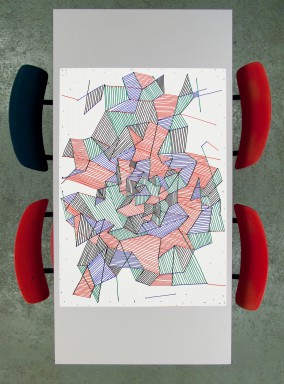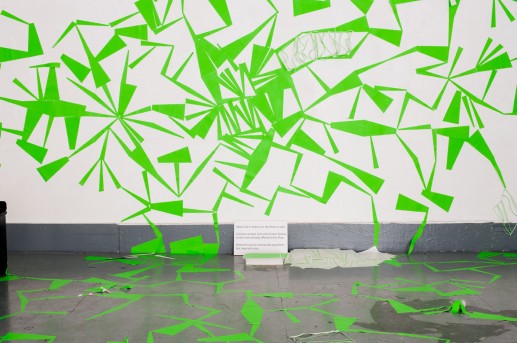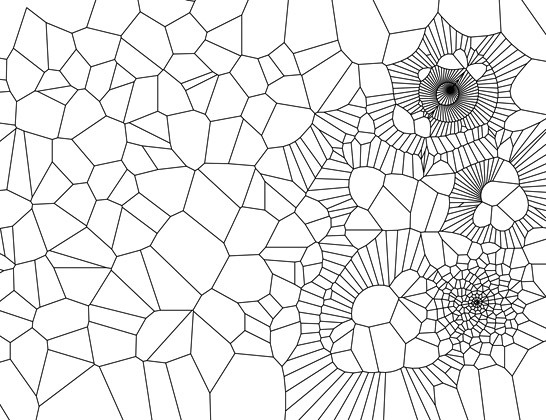
Conditional Design Posters, 2009
Since spring 2008 we (Luna Maurer, Edo Paulus, Jonathan Puckey and Roel Wouters) come together every tuesday at Luna's kitchen table. Aside from working on the Conditional Design Manifesto we organize weekly Conditional Design workshops and publish the results on our Conditional Design website. These posters are also one of the results of these workshops. For the posters, every week one of us had to define the rules that we will execute during one evening. We never know exactly how the patterns will emerge. Sometimes, the patterns are complex and the rules are simple and sometimes the patterns are simple and the rules as well.

Milen en Joes gaan trouwen, 2009
Wedding invitation for Joes & Milen. The poster design is constructed with one long line. Jonathan Puckey modified his Ribbon Tool for this purpose.

Red Fungus, 2010
Having only four stickers consisting of basic shapes � two sizes of lines and circles � limits the scope of expression. It is exactly these limitations that will force the visitors to act like a machine, though one with a bit of creativity. While each visitor executes only a simple task, the repetition of these tasks, combined with the collaboration of other visitors, will lead to a more complex image. The freedom of direction and positioning of the sticker (within the limits of the rules) confronts the visitors with the impossibility of making an arbitrary choice. Patterns emerge because people will observe what others previously have done and react accordingly. So, ultimately the visitors work as a collective in the creation of an image. In this way, Red Fungus investigates the relation of emergence and (un)conscious human action. Rules: 1 - Connect the stickers to the ones already affixed to the floor. 2 - Elements can be connected anywhere but may not cross over each other. 3 - Open line-ends are not allowed: connect them to other lines or to a circle. Concept of the exhibition: Before the background of unforeseen global processes, credit crash and climate change, the exhibition el proceso como paradigma researches the nature of processes and self organising, processual systems on a cultural level and in the arts. el proceso como paradigma puts forward the idea that today processes have become one of the major paradigms and creative strategies in contemporary art and design across the disciplines. The show reveals the elementary shift from a culture based on the concept of manifestation and the final product to a culture of process resulting from a networked society. Consequently, the show introduces a new understanding of process-based art which goes beyond previous definitions. el proceso como paradigma suggests that the new process-based art is the art of the 21st century.

Green Grass Fungus, 2011
Green Grass Fungus is a new variation of the 'Fungus-Series'. It was executed as part of the exhibition 'Read The Rules Before You Use The Pool', Index Festival, New York, 18th - 27th of august 2011.

Jetzt Now, 2005
The publication Jetzt/Now is a catalogue for the festival as well as Luna's (artist-) contribution to the exhibition. The traditional catalogue is interspersed with a text that describes the process of the "book in making", (in green typography). This text flows through the book independent of it's editorial content. The timeline goes backwards: it starts on the cover with the moment of the purchase of the (finished) book and goes backwards until the end of the book where the reader is left with the mere plan of making a book. Kathrin Hero rewrote everything that happened while making the book into a narrative form. She chose to write it from the book's perspective, interacting with everyone involved with the project. Jonathan Puckey was approached to use his Lettering Tool to make the calligraphy on the cover that requests people to write down the date of purchase on the book.

Voronoi Tool for Dinie Besems, 2006
I decided to use the mathematical principles that are discovered a lot in nature: The Voronoi-Diagram and the Delaunay Triangulation The Voronoi Diagram has the property that for each site every point in the region around that site is closer to that site than to any of the other sites. The Delaunay Triangulation is the geometric dual of the Voronoi Diagram. Alternately, it can be defined as a triangulation of the sites with the additional property that for each triangle of the triangulation, the circumcircle of that triangle is empty of all other sites. These closely related data structures have been found to be among the most useful data structures of the field of 'Computational Geometry'. The images show some screenshots how the website-tool is constructed, and documentation of how Dinie applies the tool to different kind of media. Jewelry, exhibition design, fashion... I designed with the tool the invitation and banner for her exhibition "LoloFerrari", October 2006 - January 2007 in De Zonnehof, Almere, The Netherlands. Programming tool: Karel de Vos